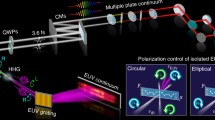Abstract
Supercontinuum generation is dependent on the polarization state of the incident laser. The polarization of the generated supercontinuum is the same as that of the incident laser. The magnitude of the generated supercontinuum depends on the polarization of the incident laser and increases as the polarization changes from circular to linear, irrespective of the nature of the sample, be it isotropic, anisotropic, or chiral. In all samples, the polarization dependence indicates a preference for the linear component of the incident laser beam. The anisotropic sample shows an additional difference in the generated supercontinuum for the two perpendicular directions of the incident laser polarization.
Similar content being viewed by others
References
R.R. Alfano (Ed.): The Supercontinuum Laser Source (Springer-Verlag, New York 1989)
A. Penzkofer, A. Laubereau, W. Kaiser: Phys. Rev. Lett. 31, 863 (1973)
P.B. Corkum, C. Rolland, T. Srinivasan-Rao: Phys. Rev. Lett. 57, 2268 (1986)
P.B. Corkum, C. Rolland IEEE J. Quantum Electron. QE-25, 2634 (1989)
A. Penzkofer, A. Beidoun, H.-J. Lehmeir: Opt. Quantum Electron. 25, 317 (1993)
W.L. Smith, P. Liu, N. Bloembergen: Phys. Rev. A 15, 2396 (1977)
G.Y. Yang, Y.R. Shen: Opt. Lett. 9, 510 (1984)
R.R. Alfano, S.L. Shapiro: Phys. Rev. Lett. 24, 584 (1970)
G.S. He, G.C. Xu, Y. Cui, P.N. Prasad: Appl. Opt. 32, 4507 (1993)
M. Wittmann, A. Penzkofer: Opt. Commun. 126, 308 (1996)
A. Brodeur, F.A. Ilkov, S.L. Chin, O.G. Kosareva, V.P. Kandidov: Opt. Lett. 22, 304 (1997)
J. Ranka, R.W. Schirmer, A. Gaeta: Phys. Rev. Lett. 77, 3783 (1983)
A. Brodeur, S.L. Chin: J. Opt. Soc. Am. B 16, 637 (1999)
N. Bloembergen: Opt. Commun. 8, 285 (1973)
A. Brodeur, S.L. Chin: Phys. Rev. Lett. 80, 4406 (1998)
G.P. Agrawal: Nonlinear Fiber Optics (Academic Press, Boston 1989)
A.S. Sandhu, S. Bannerjee, D. Goswami: Opt. Commun. 181, 101 (2000)
G. Fibich, B. Ilan: Phys. Rev. Lett. 89, 013901 (2002)
A.M. Perelomov, V.S. Popov, M.V. Terent’ev: Sov. Phys. JETP 23, 924 (1966); S.L. Chin, P. Lambropoulos: Multiphoton Ionization of Atoms (Academic Press Canada, Toronto, Canada 1984)
G.H. Wagniere: Linear and Nonlinear Optical Properties of Molecules (Verlag Helvetica Chimita Acta, Basel 1993) p. 20
R.W. Boyd: Nonlinear Optics (Academic Press, San Diego 1992)
Author information
Authors and Affiliations
Corresponding author
Additional information
PACS
42.25.Ja; 42.65.Ky
Rights and permissions
About this article
Cite this article
Srivastava, A., Goswami, D. Control of supercontinuum generation with polarization of incident laser pulses. Appl Phys B 77, 325–328 (2003). https://doi.org/10.1007/s00340-003-1243-2
Received:
Accepted:
Published:
Issue Date:
DOI: https://doi.org/10.1007/s00340-003-1243-2




